Portia Dailymed
Generic: levonorgestrel and ethinyl estradiol is used for the treatment of Breast Neoplasms Cerebral Arterial Diseases Coronary Artery Disease Hypertension Hypogonadism Liver Diseases Menopause, Premature Menorrhagia Neoplasms, Hormone-Dependent Pregnancy Prostatic Neoplasms Thromboembolism Thrombophlebitis Osteoporosis, Postmenopausal Primary Ovarian Insufficiency Endometrial Neoplasms Hot Flashes Tobacco Use Abortion, Spontaneous Cerebrovascular Disorders Coronary Disease Diabetes Mellitus Heart Valve Diseases Jaundice Kidney Diseases Liver Neoplasms Tobacco Use Disorder Uterine Hemorrhage Adenoma, Liver Cell Headache Disorders
IMPRINT: B 208
SHAPE: round
COLOR: white
All Imprints
levonorgestrel 0.15 mgethinyl estradiol 0.03 mg - b 992 round pink
- b 208 round white
Boxed Warning
Boxed Warning Section
Go PRO for all pill images
Boxed Warning Section
WARNING: CIGARETTE SMOKING AND SERIOUS CARDIOVASCULAR EVENTS
Cigarette smoking increases the risk of serious cardiovascular events from combination oral contraceptive (COC) use. This risk increases with age, particularly in women over 35 years of age, and with the number of cigarettes smoked. For this reason, COCs, including Portia, are contraindicated in women who are over 35 years of age and smoke [see CONTRAINDICATIONSĀ and WARNINGS (1)].
Description
Portia Ā® (levonorgestrel and ethinyl estradiol tablets USP) is a combination oral contraceptive (COC) consisting of 21 pink active tablets, each containing 0.15 mg of levonorgestrel, USP, a synthetic progestin and 30 mcg of ethinyl estradiol, USP, an estrogen, and 7 white inert tablets (without hormones).
The structural formulas for the active components are:

Levonorgestrel, USP C21H28O2Ā Ā Ā Ā Ā Ā Ā Ā M.W. 312.45 Ā
Levonorgestrel, USP is chemically 18,19-Dinorpregn-4-en-20-yn-3-one, 13-ethyl-17-hydroxy-,(17Ī±)-(-)-.

Ethinyl Estradiol, USP C20H24O2Ā Ā Ā Ā Ā Ā M.W. 296.40
Ethinyl Estradiol, USP is 19-nor-17Ī±-pregna-1,3,5(10)-trien-20-yne-3, 17-diol.
Each pink active tablet contains the following inactive ingredients: anhydrous lactose, hypromellose, magnesium stearate, and microcrystalline cellulose. The ingredients in the film-coating include FD&C blue no. 1 aluminum lake, FD&C red no. 40 aluminum lake, hypromellose, polyethylene glycol, polysorbate 80, and titanium dioxide.
Each white inert tablet contains the following inactive ingredients: anhydrous lactose, hypromellose, magnesium stearate, and microcrystalline cellulose.
Clinical Pharmacology
Combination oral contraceptives prevent pregnancy primarily by suppressing ovulation.
Indications And Usage
Portia (levonorgestrel and ethinyl estradiol tablets USP) is indicated for use by females of reproductive potential to prevent pregnancy.
Contraindications
Portia (levonorgestrel and ethinyl estradiol tablets USP) is contraindicated in females who are known to have the following conditions:
- A high risk of arterial or venous thrombotic diseases. Examples include women who are known to:
- Smoke, if over age 35 [see BOXED WARNING and WARNINGS (1) ].
- Have current or history of deep vein thrombosis or pulmonary embolism [see WARNINGS (1) ].
- Have cerebrovascular disease [see WARNINGS (1) ].
- Have coronary artery disease [see WARNINGS (1) ].
- Have thrombogenic valvular or thrombogenic rhythm diseases of the heart (for example, subacute bacterial endocarditis with valvular disease, or atrial fibrillation) [see WARNINGS (1) ].
- Have inherited or acquired hypercoagulopathies [see WARNINGS (1) ].
- Have uncontrolled hypertension or hypertension with vascular disease [see WARNINGS (3) ].
- Have diabetes mellitus and are over age 35, diabetes mellitus with hypertension or vascular disease or other end-organ damage, or diabetes mellitus of >20 years duration [see WARNINGS (7) ].
- Have headaches with focal neurological symptoms, migraine headaches with aura, or over age 35 with any migraine headaches [see WARNINGS (8) ].
- Current diagnosis of, or history of, breast cancer, which may be hormone-sensitive.
- Liver tumors, acute viral hepatitis, or severe (decompensated) cirrhosis [see WARNINGS (2) ].
- Use of Hepatitis C drug combinations containing ombitasvir/paritaprevir/ritonavir, with or without dasabuvir, due to the potential for ALT elevations [see WARNINGS (5) ].
- Undiagnosed abnormal uterine bleeding [see WARNINGS (9) ].
Warnings
1. Thromboembolic Disorders and Other Vascular Conditions
- Stop Portia if an arterial or venous thrombotic/thromboembolic event occurs.
- Stop Portia if there is unexplained loss of vision, proptosis, diplopia, papilledema, or retinal vascular lesions and evaluate for retinal vein thrombosis immediately.
- Discontinue Portia during prolonged immobilization. If feasible, stop Portia at least four weeks before and through two weeks after major surgery, or other surgeries known to have an elevated risk of thromboembolism.
- Start Portia no earlier than four weeks after delivery in females who are not breast-feeding. The risk of postpartum thromboembolism decreases after the third postpartum week, whereas the likelihood of ovulation increases after the third postpartum week.
- Before starting Portia evaluate any past medical history or family history of thrombotic or thromboembolic disorders and consider whether the history suggests an inherited or acquired hypercoagulopathy. Portia is contraindicated in females with a high risk of arterial or venous thrombotic/thromboembolic diseases (seeĀ CONTRAINDICATIONS ).
Arterial Events
COCs increase the risk of cardiovascular events and cerebrovascular events, such as myocardial infarction and stroke. The risk is greater among older women (> 35 years of age), smokers, and females with hypertension, dyslipidemia, diabetes, or obesity.
Portia is contraindicated in women over 35 years of age who smoke (seeĀ CONTRAINDICATIONS ). Cigarette smoking increases the risk of serious cardiovascular events from COC use. This risk increases with age, particularly in women over 35 years of age, and with the number of cigarettes smoked.
Venous Events
Use of COCs increases the risk of venous thromboembolic events (VTEs), such as deep vein thrombosis and pulmonary embolism. Risk factors for VTEs include smoking, obesity, and family history of VTE, in addition to other factors that contraindicate use of COCs (seeĀ CONTRAINDICATIONS ). While the increased risk of VTE associated with use of COCs is well-established, the rates of VTE are even greater during pregnancy, and especially during the postpartum period (see Figure 1). The rate of VTE in females using COCs has been estimated to be 3 to 9 cases per 10,000 woman-years.
The risk of VTE is highest during the first year of use of a COC and when restarting hormonal contraception after a break of four weeks or longer. Based on results from a few studies, there is some evidence that this is true for non-oral products as well. The risk of thromboembolic disease due to COCs gradually disappears after COC use is discontinued.
Figure 1 shows the risk of developing a VTE for females who are not pregnant and do not use oral contraceptives, for females who use oral contraceptives, for pregnant females, and for females in the postpartum period. To put the risk of developing a VTE into perspective: If 10,000 females who are not pregnant and do not use oral contraceptives are followed for one year, between 1 and 5 of these females will develop a VTE.
Figure 1: Likelihood of Developing a VTE
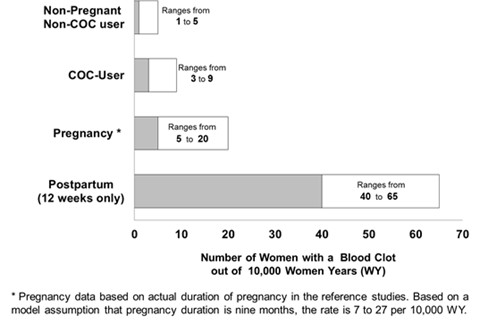
2. Liver Disease
Elevated Liver Enzymes
Portia is contraindicated in females with acute viral hepatitis or severe (decompensated) cirrhosis of liver (seeĀ CONTRAINDICATIONS ). Discontinue Portia if jaundice develops. Acute liver test abnormalities may necessitate the discontinuation of COC use until the liver tests return to normal and COC causation has been excluded.
Liver Tumors
Portia is contraindicated in females with benign or malignant liver tumors (seeĀ CONTRAINDICATIONS ). COCs increase the risk of hepatic adenomas. An estimate of the attributable risk is 3.3 cases/100,000 COC users. Rupture of hepatic adenomas may cause death from abdominal hemorrhage.
Studies have shown an increased risk of developing hepatocellular carcinoma in long-term (> 8 years) COC users. The attributable risk of liver cancers in COC users is less than one case per million users.
3. Hypertension
Portia is contraindicated in females with uncontrolled hypertension or hypertension with vascular disease (seeĀ CONTRAINDICATIONS ). For all females, including those with well-controlled hypertension, monitor blood pressure at routine visits and stop Portia if blood pressure rises significantly.
An increase in blood pressure has been reported in females using COCs, and this increase is more likely in older women with extended duration of use. The effect of COCs on blood pressure may vary according to the progestin in the COC.
4. Age-related Considerations
The risk for cardiovascular disease and prevalence of risk factors for cardiovascular disease increase with age. Certain conditions, such as smoking and migraine headache without aura, that do not contraindicate COC use in younger females, are contraindications to use in women over 35 years of age [seeĀ CONTRAINDICATIONS Ā andĀ WARNINGS (1) ]. Consider the presence of underlying risk factors that may increase the risk of cardiovascular disease or VTE, particularly before initiating a COC for women over 35 years, such as:
- Hypertension
- Diabetes
- Dyslipidemia
- ObesityĀ
5. Risk of Liver Enzyme Elevations with Concomitant Hepatitis C Treatment
During clinical trials with the Hepatitis C combination drug regimen that contains ombitasvir/paritaprevir/ritonavir, with or without dasabuvir, ALT elevations greater than 5 times the upper limit of normal (ULN), including some cases greater than 20 times the ULN, were significantly more frequent in women using ethinyl estradiol-containing medications such as COCs. Discontinue Portia prior to starting therapy with the combination drug regimen ombitasvir/paritaprevir/ritonavir, with or without dasabuvir (seeĀ CONTRAINDICATIONS ). Portia can be restarted approximately 2 weeks following completion of treatment with the combination drug regimen.
6. Gallbladder Disease
Studies suggest an increased risk of developing gallbladder disease among COC users. Use of COCs may also worsen existing gallbladder disease.
A past history of COC-related cholestasis predicts an increased risk with subsequent COC use. Females with a history of pregnancy-related cholestasis may be at an increased risk for COC-related cholestasis.
7. Adverse Carbohydrate and Lipid Metabolic Effects
Hyperglycemia
Portia is contraindicated in diabetic women over age 35, or females who have diabetes with hypertension, nephropathy, retinopathy, neuropathy, other vascular disease, or females with diabetes of > 20 years duration (seeĀ CONTRAINDICATIONS ). Portia may decrease glucose tolerance. Carefully monitor prediabetic and diabetic females who are using Portia.
Dyslipidemia
Consider alternative contraception for females with uncontrolled dyslipidemia. Portia may cause adverse lipid changes.
Females with hypertriglyceridemia, or a family history thereof, may have an increase in serum triglyceride concentrations when using Portia, which may increase the risk of pancreatitis.
8. Headache
Portia is contraindicated in females who have headaches with focal neurological symptoms or have migraine headaches with aura, and in women over age 35 years who have migraine headaches with or without aura (seeĀ CONTRAINDICATIONS ).
If a woman using Portia develops new headaches that are recurrent, persistent, or severe, evaluate the cause and discontinue Portia if indicated. Consider discontinuation of Portia if there is an increased frequency or severity of migraines during COC use (which may be prodromal of a cerebrovascular event).
9. Bleeding Irregularities and Amenorrhea
Unscheduled Bleeding and Spotting
Females using Portia may experience unscheduled (breakthrough or intracyclic) bleeding and spotting, especially during the first three months of use. Bleeding irregularities may resolve over time or by changing to a different contraceptive product. If bleeding persists or occurs after previously regular cycles, evaluate for causes such as pregnancy or malignancy.
In two clinical trials of Portia (1084 subjects reporting for a total of 8186 treatment cycles and 238 subjects reporting for a total of 1102 treatment cycles), breakthrough bleeding occurred in 6.9% and 8.1% of reported cycles, and spotting occurred in 8.6% and 7.9% of reported cycles over the total study duration, respectively. In the two trials, intermenstrual bleeding (i.e., breakthrough bleeding and/or spotting) occurred in 13.1% and 12.9% of reported cycles over the total study duration, respectively. In one trial, 33 subjects out of 1084 (3.0%) discontinued due to bleeding irregularities (i.e., breakthrough bleeding and spotting); in the other trial, 6 subjects out of 238 (2.5%) discontinued due to bleeding irregularities.
Amenorrhea and Oligomenorrhea
Females who use Portia may experience absence of scheduled (withdrawal) bleeding, even if they are not pregnant. In two clinical trials of Portia, one including 8186 reported treatment cycles, and the other including 1102 reported treatment cycles, amenorrhea occurred in 1.5% of treatment cycles in each trial.
If scheduled bleeding does not occur, consider the possibility of pregnancy. If the patient has not adhered to the prescribed dosing schedule (missed one or two active tablets or started taking them on a day later than she should have), consider the possibility of pregnancy at the time of the first missed period and perform appropriate diagnostic measures. If the patient has adhered to the prescribed dosing schedule and misses two consecutive periods, rule out pregnancy.
After discontinuation of a COC, amenorrhea or oligomenorrhea may occur, especially if these conditions were pre-existent.
10. Depression
Carefully observe females with a history of depression and discontinue Portia if depression recurs to a serious degree. Data on the association of COCs with onset of depression or exacerbation of existing depression are limited.
11. Malignant Neoplasms
Breast Cancer
Portia is contraindicated in females who currently have or have had breast cancer because breast cancer may be hormonally sensitive [see CONTRAINDICATIONS (4) ].
Epidemiology studies have not found a consistent association between use of combined oral contraceptives (COCs) and breast cancer risk. Studies do not show an association between ever (current or past) use of COCs and risk of breast cancer. However, some studies report a small increase in the risk of breast cancer among current or recent users (<6 months since last use) and current users with longer duration of COC use (see ADVERSE REACTIONS, Postmarketing Experience ).
Cervical Cancer
Some studies suggest that COCs are associated with an increase in the risk of cervical cancer or intraepithelial neoplasia. There is controversy about the extent to which these findings are due to differences in sexual behavior and other factors.
12. Effect on Binding Globulins
The estrogen component of Portia may raise the serum concentrations of thyroxine-binding globulin, sex hormone-binding globulin, and cortisol-binding globulin. The dose of replacement thyroid hormone or cortisol therapy may need to be increased.
13. Hereditary Angioedema
In females with hereditary angioedema, exogenous estrogens may induce or exacerbate symptoms of angioedema.
14. Chloasma
Chloasma may occur with Portia use, especially in females with a history of chloasma gravidarum. Advise females with a history of chloasma to avoid exposure to the sun or ultraviolet radiation while using Portia.
Precautions
1. Lipid Disorders
Women who are being treated for hyperlipidemias should be followed closely if they elect to use oral contraceptives. Some progestogens may elevate LDL levels and may render the control of hyperlipidemias more difficult [see WARNINGSĀ (7) ].
In patients with familial defects of lipoprotein metabolism receiving estrogen-containing preparations, there have been case reports of significant elevations of plasma triglycerides leading to pancreatitis.
2. Fluid Retention
Oral contraceptives may cause some degree of fluid retention. They should be prescribed with caution, and only with careful monitoring, in patients with conditions which might be aggravated by fluid retention.
3. GastrointestinalMotility
Diarrhea and/or vomiting may reduce hormone absorption (see DOSAGE AND ADMINISTRATION ).
4. Drug Interactions
The sections below provide information on substances for which data on drug interactions with COCs are available. There is little information available about the clinical effect of most drug interactions that may affect COCs. However, based on the known pharmacokinetic effects of these drugs, clinical strategies to minimize any potential adverse effect on contraceptive effectiveness or safety are suggested.
Consult the approved product labeling of all concurrently used drugs to obtain further information about interactions with COCs or the potential for metabolic enzyme or transporter system alterations.
No drug-drug interaction studies were conducted with Portia.
4.1 Effects of Other Drugs on Combined Oral Contraceptives
Substances Decreasing the Plasma Concentrations of COCs and Potentially Diminishing the Efficacy of COCs:
Table 1 includes substances that demonstrated an important drug interaction with Portia.
Table 1: Significant Drug Interactions Involving Substances That Affect COCs
Metabolic Enzyme Inducers
Clinical effect
- Concomitant use of COCs with metabolic enzyme inducers may decrease the plasma concentrations of the estrogen and/or progestin component of COCs.
- Decreased exposure of the estrogen and/or progestin component of COCs may potentially diminish the effectiveness of COCs and may lead to contraceptive failure or an increase in breakthrough bleeding.
Prevention or management
- Counsel females to use an alternative method of contraception or a backup method when enzyme inducers are used with COCs.
- Continue backup contraception for 28 days after discontinuing the enzyme inducer to maintain contraceptive reliability.
Examples
Aprepitant, barbiturates, bosentan, carbamazepine, efavirenz, felbamate, griseofulvin, oxcarbazepine, phenytoin, rifampin, rifabutin, rufinamide, topiramate, products containing St. Johnās worta, and certain protease inhibitors (see separate section on protease inhibitors below).
Colesevelam
Clinical effect
- Concomitant use of COCs with colesevelam significantly decreases systemic exposure of ethinyl estradiol.
- Decreased exposure of the estrogen component of COCs may potentially reduce contraceptive efficacy or result in an increase in breakthrough bleeding, depending on the strength of ethinyl estradiol in the COC.
Prevention or management
Administer 4 or more hours apart to attenuate this drug interaction.
a Induction potency of St. Johnās wort may vary widely based on preparation.
Substances increasing the systemic exposure of COCs:
Co-administration of atorvastatin or rosuvastatin and COCs containing ethinyl estradiol increase systemic exposure of ethinyl estradiol by approximately 20 to 25 percent. Ascorbic acid and acetaminophen may increase systemic exposure of ethinyl estradiol, possibly by inhibition of conjugation. CYP3A inhibitors such as itraconazole, voriconazole, fluconazole, grapefruit juice,7 or ketoconazole may increase systemic exposure of the estrogen and/or progestin component of COCs.
Human immunodeficiency virus (HIV)/hepatitis C virus (HCV) protease inhibitors and non-nucleoside reverse transcriptase inhibitors:
Significant decreases in systemic exposure of the estrogen and/or progestin have been noted when COCs are co-administered with some HIV protease inhibitors (e.g., nelfinavir, ritonavir, darunavir/ritonavir, (fos) amprenavir/ritonavir, lopinavir/ritonavir, and tipranavir/ritonavir), some HCV protease inhibitors (e.g., boceprevir and telaprevir), and some non-nucleoside reverse transcriptase inhibitors (e.g., nevirapine).
In contrast, significant increases in systemic exposure of the estrogen and/or progestin have been noted when COCs are co-administered with certain other HIV protease inhibitors (e.g., indinavir and atazanavir/ritonavir) and with other non-nucleoside reverse transcriptase inhibitors (e.g., etravirine).
4.2 Effects of Combined Oral Contraceptives on Other Drugs
Table 2 provides significant drug interaction information for drugs co-administered with Portia.
Table 2: Significant Drug Interaction Information for Drugs Co-Administered With COCs
Lamotrigine
Clinical effect
- Concomitant use of COCs with lamotrigine may significantly decrease systemic exposure of lamotrigine due to induction of lamotrigine glucuronidation.
- Decreased systemic exposure of lamotrigine may reduce seizure control.
Prevention or management
Dose adjustment may be necessary. Consult the approved product labeling for lamotrigine.
Thyroid Hormone Replacement Therapy or Corticosteroid Replacement Therapy
Clinical effect
Concomitant use of COCs with thyroid hormone replacement therapy or corticosteroid replacement therapy may increase systemic exposure of thyroid-binding and cortisol-binding globulin (see Warnings ,Ā EFFECT ON BINDING GLOBULINS ).
Prevention or management
The dose of replacement thyroid hormone or cortisol therapy may need to be increased. Consult the approved product labeling for the therapy in use (see Warnings ,Ā EFFECT ON BINDING GLOBULINS ).
Other Drugs
Clinical effect
Concomitant use of COCs may decrease systemic exposure of acetaminophen, morphine, salicylic acid, and temazepam. Concomitant use with ethinyl estradiol-containing COCs may increase systemic exposure of other drugs (e.g., cyclosporine, prednisolone, theophylline, tizanidine, and voriconazole).
Prevention or management
The dosage of drugs that can be affected by this interaction may need to be increased. Consult the approved product labeling for the concomitantly used drug.
4.3 Concomitant Use with Hepatitis C Virus (HCV) Combination Therapy ā Liver Enzyme Elevation
Do not co-administer Portia with HCV drug combinations containing ombitasvir/paritaprevir/ritonavir, with or without dasabuvir, [see Warnings (5) ], and glecaprevir/pibrentasvir due to potential for ALT elevations.
4.4 Effect on Laboratory Tests
The use of COCs may influence the results of certain laboratory tests, such as coagulation factors, lipids, glucose tolerance, and binding proteins.
5. Carcinogenesis
See WARNINGSĀ (11) .
6. Pregnancy
Risk Summary
Discontinue Portia if pregnancy occurs because there is no reason to use COCs in pregnancy. Epidemiologic studies and meta-analyses have not found an increased risk of genital or nongenital birth defects (including cardiac anomalies and limb-reduction defects) following exposure to COCs before conception or during early pregnancy. Animal studies to evaluate embryo/fetal toxicity were not conducted.
In the U.S. general population, the estimated background risk of major birth defects and miscarriage in clinically recognized pregnancies is 2 to 4 percent and 15 to 20 percent, respectively.
7. Lactation
Risk Summary
Contraceptive hormones and/or metabolites are present in human milk. COCs can reduce milk production in breast-feeding females. This reduction can occur at any time but is less likely to occur once breast-feeding is well-established. When possible, advise the nursing female to use other methods of contraception until she discontinues breast-feeding. (see DOSAGE AND ADMINISTRATION ). The developmental and health benefits of breast-feeding should be considered along with the motherās clinical need for Portia and any potential adverse effects on the breast-fed child from Portia or from the underlying maternal condition.
8. Pediatric Use
Safety and efficacy of Portia have been established in females of reproductive potential. Use of Portia before menarche is not indicated.
9. Geriatric Use
Portia has not been studied in postmenopausal women and is not indicated in this population.
10. PATIENTCOUNSELING INFORMATION
- Counsel patients that cigarette smoking increases the risk of serious cardiovascular events from COC use, and that women who are over 35 years old and smoke should not use COCs (see BOXED WARNING and CONTRAINDICATIONS ).
- Counsel patients that this product does not protect against HIV-infection (AIDS) and other sexually transmitted infections.
- Counsel patients to take one tablet daily by mouth at the same time every day. Instruct patients what to do in the event pills are missed (see DOSAGE AND ADMINISTRATION ).
- Counsel patients to use a back-up or alternative method of contraception when enzyme inducers are used with COCs [see PRECAUTIONS (4.1) ].
- Counsel patients who are breastfeeding or who desire to breastfeed that COCs may reduce breast milk production. This is less likely to occur if breastfeeding is well established [see PRECAUTIONS (7) ].
- Counsel any patient who starts Portia postpartum, and who has not yet had a period, to use an additional method of contraception until she has taken a pink tablet for 7 consecutive days (see DOSAGE AND ADMINISTRATION ).
- Counsel patients that amenorrhea may occur. Pregnancy should be considered in the event of amenorrhea, and should be ruled out if amenorrhea is associated with symptoms of pregnancy, such as morning sickness or unusual breast tenderness [see WARNINGS (9) ].
- Depression may occur. Women should contact their healthcare provider if depression occurs, including shortly after initiating the treatment [see WARNINGS (10) ].
Adverse Reactions
The following serious adverse reactions with the use of COCs are discussed elsewhere in the labeling:
- Serious cardiovascular adverse events [see BOXED WARNING and WARNINGS (1) ]
- Vascular events [see WARNINGS (1) ]
- Liver disease [see WARNINGS (2) ]
- Hypertension [see WARNINGS (3) ]
- Gallbladder disease [see WARNINGS (6) ]
- Carbohydrate and lipid effects [see WARNINGS (7) ]
- Headache [see WARNINGS (8) ]
- Carcinoma of the cervix [see WARNINGS (11) ]
Adverse reactions reported by COC users and described elsewhere in the labeling are:
- Bleeding irregularities and amenorrhea [see WARNINGS (9) ]
- Mood changes, including depression [see WARNINGS (10) ]
- Melasma/chloasma which may persist [see WARNINGS (14) ]
- Edema/fluid retention [see PRECAUTIONS (2) ]
- Diminution in lactation when given immediately postpartum [see PRECAUTIONS (7) ]
Post Marketing Experience
Five studies that compared breast cancer risk between ever-users (current or past use) of COCs and never-users of COCs reported no association between ever use of COCs and breast cancer risk, with effect estimates ranging from 0.90 to 1.12 (Figure 2).
Three studies compared breast cancer risk between current or recent COC users (<6 months since last use) and never users of COCs (Figure 2). One of these studies reported no association between breast cancer risk and COC use. The other two studies found an increased relative risk of 1.19 to 1.33 with current or recent use. Both of these studies found an increased risk of breast cancer with current use of longer duration, with relative risks ranging from 1.03 with less than one year of COC use to approximately 1.4 with more than 8 to 10 years of COC use.
Figure 2: Relevant Studies of Risk of Breast Cancer with Combined Oral Contraceptives
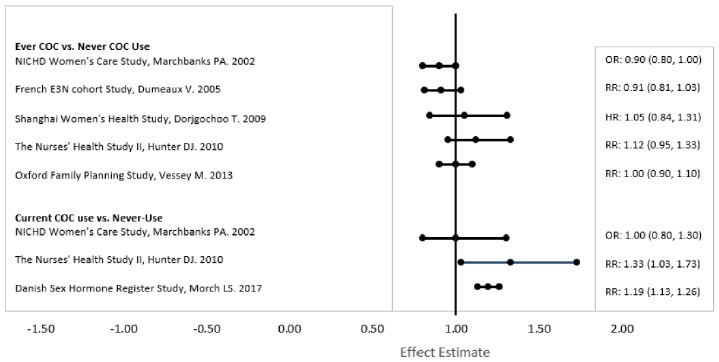
RR = relative risk; OR = odds ratio; HR = hazard ratio. āever COCā are females with current or past COC use; ānever COC useā are females that never used COCs.
The following adverse reactions have been reported in patients receiving oral contraceptives and are believed to be drug-related: Breast tenderness, pain, enlargement, secretion; Nausea, vomiting and gastrointestinal symptoms (such as abdominal pain, cramps and bloating); Change in menstrual flow; Temporary infertility after discontinuation of treatment; Change in weight or appetite (increase or decrease); Change in cervical erosion and secretion; Cholestatic jaundice; Rash (allergic); Vaginitis, including candidiasis; Change in corneal curvature (steepening); Intolerance to contact lenses; Mesenteric thrombosis; Decrease in serum folate levels; Exacerbation of systemic lupus erythematosus; Exacerbation of porphyria; Exacerbation of chorea; Aggravation of varicose veins; Anaphylactic/anaphylactoid reactions, including urticaria, angioedema, and severe reactions with respiratory and circulatory symptoms.
The following adverse reactions have been reported in users of oral contraceptives, and the association has been neither confirmed nor refuted: Congenital anomalies; Premenstrual syndrome; Cataracts; Optic neuritis, which may lead to partial or complete loss of vision; Cystitis-like syndrome; Nervousness; Dizziness; Hirsutism; Loss of scalp hair; Erythema multiforme; Erythema nodosum; Hemorrhagic eruption; Impaired renal function; Hemolytic uremic syndrome; Budd-Chiari syndrome; Acne; Changes in libido; Colitis; Sickle-cell disease; Cerebral-vascular disease with mitral valve prolapse; Lupus-like syndromes; Pancreatitis; Dysmenorrhea.
To report SUSPECTED ADVERSE EVENTS, contact Teva at 1-888-838-2872 or FDA at 1-800-FDA-1088 or http://www.fda.gov/medwatch for voluntary reporting of adverse reactions.
Overdosage
There have been no reports of serious adverse outcomes from overdose of COCs, including ingestion by children. Overdose may cause uterine bleeding in females and nausea.
Dosage And Administration
1. How to Start and Take Portia
Portia is dispensed in a buler card containing 28 tablets (see HOW SUPPLIED ). Portia may be started using either a Day 1 start or a Sunday start (see Table 3). For the first cycle of a Sunday start regimen, an additional method of contraception should be used until after the first 7 consecutive days of administration.
Table 3: Instructions for Administration of Portia
Starting Portia in females with no current use of hormonal contraception
Day 1 start
- Take first tablet without regard to meals on the first day of menses
- Take subsequent tablets once daily at the same time each day
- Begin each subsequent pack on the same day of the week as the first cycle pack (i.e., on the day after taking the last tablet)
Sunday start
- Take first tablet without regard to meals on the first Sunday after the onset of menstrual period
- Take subsequent tablets once daily at the same time each day
- Use additional nonhormonal contraception for the first seven days of product use
- Begin each subsequent pack on the same day of the week as the first cycle pack (i.e., on the day after taking the last tablet)
Switching from another contraceptive method
- A COC
Start Portia:
- On the day when the new pack of the previous COC would have been started
- Transdermal patch
- On the day when next application would have been scheduled
- Vaginal ring
- On the day when next insertion would have been scheduled
- Injection
- On the day when next injection would have been scheduled
- Intrauterine contraceptive
- On the day of removal
- Implant
- On the day of removal
Starting Portia after Abortion or Miscarriage
First-trimester
- After a first-trimester abortion or miscarriage, Portia may be started immediately. An additional method of contraception is not needed if Portia is started immediately.
- If Portia is not started within 5 days after termination of the pregnancy, the patient should use additional non-hormonal contraception (such as condoms or spermicide) for the first seven days of her first cycle of Portia.
Second-trimester
- Do not start until 4 weeks after a second-trimester abortion or miscarriage, due to the increased risk of thromboembolic disease. Start Portia following the instructions in Table 3 for Day 1 or Sunday start. Use additional non-hormonal contraception (such as condoms or spermicide) for the first seven days of the patientās first cycle of Portia (see CONTRAINDICATIONS , WARNINGS (1) , PRECAUTIONS (10) and FDA-APPROVED PATIENT LABELING ).
Starting Portia after Childbirth
- Do not start until 4 weeks after delivery, due to the increased risk of thromboembolic disease. Start contraceptive therapy with Portia following the instructions in Table 3 for women not currently using hormonal contraception.
- Portia is not recommended for use in lactating women (see PRECAUTIONS (7) Ā and FDA-APPROVED PATIENT LABELING ).
- If the woman has not yet had a period postpartum, consider the possibility of ovulation and conception occurring prior to use of Portia (see CONTRAINDICATIONS , WARNINGS (9) , PRECAUTIONS (6) and FDA-APPROVED PATIENT LABELING ).
2. Dosing Portia
Instruct patients to take one tablet by mouth at the same time every day. To achieve maximum contraceptive effectiveness, patients must take Portia as directed, in the order directed on the buler pack. The failure rate may increase when pills are missed or taken incorrectly.
3. Missed doses
Instruct patients about the handling of missed doses (e.g., to take single missed pills as soon as possible) and to follow the dosing instructions provided in the FDA-approved patient labeling.
Table 4: Instructions for Missed Portia Tablets
- If one active tablet is missed in Weeks 1, 2, or 3
Take the tablet as soon as possible. Continue taking one tablet a day until the pack is finished.
- If two active tablets are missed in Week 1 or Week 2
Take the two missed tablets as soon as possible and the next two active tablets the next day. Continue taking one tablet a day until the pack is finished. Additional nonhormonal contraception (such as condoms or spermicide) should be used as back-up if the patient has sex within 7 days after missing tablets.
- If two active tablets are missed in the third week or three or more active tablets are missed in a row in Weeks 1, 2, or 3
Day 1 start: Throw out the rest of the pack and start a new pack that same day.
Sunday start: Continue taking one tablet a day until Sunday, then throw out the rest of the pack and start a new pack that same day.
Additional nonhormonal contraception (such as condoms or spermicide) should be used as back-up if the patient has sex within 7 days after missing tablets.
4. Advice in Case of Gastrointestinal Disturbances
If vomiting occurs within 3 to 4 hours after taking Portia, the patient should proceed as if she missed a tablet. In case of prolonged vomiting or diarrhea, absorption may not be complete and additional contraceptive measures should be taken.
How Supplied/storage And Handling
Portia Ā® (levonorgestrel and ethinyl estradiol tablets USP, 0.15 mg/ 0.03 mg) 28 tablets are packaged in cartons of six buler cards (NDC 0555-9020-58), each card containing 28 tablets:
21 Active Tablets:
Pink, round, film-coated, biconvex, unscored active tablets, debossed with stylized b on one side and 992 on the other side.
7 Inert Tablets:
White, round, biconvex, unscored inert tablets, debossed with stylized b on one side and 208 on the other side.
Store at 20Āŗ to 25Ā°C (68Ā° to 77Āŗ F) (See USP Controlled Room Temperature).
Keep this and all medications out of the reach of children.
Teva Pharmaceuticals USA, Inc. North Wales, PA 19454
Rev. G 11/2022
Patient Information
PORTIAĀ® (levonorgestrel and ethinyl estradiol tablets)
What is the most important information I should know about Portia?
Do not use Portia if you smoke cigarettes and are over 35 years old.Ā Smoking increases your risk of serious cardiovascular side effects from hormonal birth control pills, including death from heart attack, blood clots or stroke. This risk increases with age and the number of cigarettes you smoke.
What is Portia?
Portia is a birth control pill (oral contraceptive) used by women to prevent pregnancy.
How does Portia work for contraception?
Your chance of getting pregnant depends on how well you follow the directions for taking your birth control pills. The better you follow the directions, the less chance you have of getting pregnant.
Based on the results of clinical studies, about 1 to 5 out of 100 women may get pregnant during the first year they use Portia.
The following chart shows the chance of getting pregnant for women who use different methods of birth control. Each box on the chart contains a ul of birth control methods that are similar in effectiveness. The most effective methods are at the top of the chart. The box on the bottom of the chart shows the chance of getting pregnant for women who do not use birth control and are trying to get pregnant.
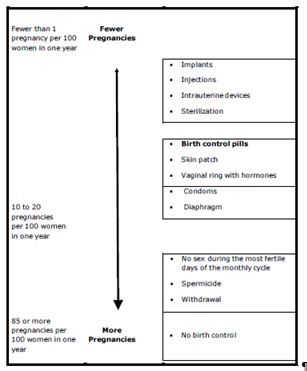
Who should not take Portia?
Do not take Portia if you:
- smoke and are over 35 years of age
- had blood clots in your arms, legs, lungs, or eyes
- had a problem with your blood that makes it clot more than normal
- have certain heart valve problems or irregular heart beat
- had a stroke
- had a heart attack
- have high blood pressure that cannot be controlled by medicine
- have diabetes with kidney, eye, nerve, or blood vessel damage
- have certain kinds of severe migraine headaches with aura, numbness, weakness or changes in vision, or any migraine headaches if you are over 35 years of age
- had breast cancer or any cancer that is sensitive to female hormones
- have liver problems, including liver tumors
- have any unexplained vaginal bleeding
- are pregnant
- take any Hepatitis C drug combination containing ombitasvir/paritaprevir/ritonavir, with or without dasabuvir. This may increase levels of the liver enzyme āalanine aminotransferaseā (ALT) in the blood.
If any of these conditions happen while you are taking Portia, stop taking Portia right away and talk to your healthcare provider. Use non-hormonal contraception when you stop taking Portia.
What should I tell my healthcare provider before taking Portia?
Tell your healthcare provider if you:
- are pregnant or think you may be pregnant
- are depressed now or have been depressed in the past
- had yellowing of your skin or eyes (jaundice) caused by pregnancy (cholestasis of pregnancy)
- are breastfeeding or plan to breastfeed. Portia may decrease the amount of breast milk you make. A small amount of the hormones in Portia may pass into your breast milk. Talk to your healthcare provider about the best birth control method for you while breastfeeding.
Tell your healthcare provider about all the medicines you take,Ā including prescription and over-the-counter medicines, vitamins and herbal supplements.
Portia may affect the way other medicines work, and other medicines may affect how well Portia works.
Know the medicines you take. Keep a ul of them to show your healthcare provider and pharmacist when you get a new medicine.
How should I take Portia?
Read the Instructions for Use at the end of this Patient Information.
What are the possible serious side effects of Portia?
- Like pregnancy, Portia may cause serious side effects, including blood clots in your lungs, heart attack, or a stroke that may lead to death. Some other examples of serious blood clots include blood clots in the legs or eyes.
Serious blood clots can happen especially if you smoke, are obese, or are older than 35 years of age. Serious blood clots are more likely to happen when you:
- first start taking birth control pills
- restart the same or different birth control pills after not using them for a month or more
Call your healthcare provider or go to a hospital emergency room right away if you have:
- leg pain that will not go away
- a sudden, severe headache unlike your usual headaches
- sudden severe shortness of breath
- weakness or numbness in your arm or leg
- sudden change in vision or blindness
- trouble speaking
- chest pain
Other serious side effects include:
- liver problems, including:
- rare liver tumors
- jaundice (cholestasis), especially if you previously had cholestasis of pregnancy. Call your healthcare provider if you have yellowing of your skin or eyes.
- high blood pressure.Ā You should see your healthcare provider for a yearly check of your blood pressure.
- gallbladder problems
- changes in the sugar and fat (cholesterol and triglycerides) levels in your blood
- new or worsening headaches, including migraine headaches
- irregular or unusual vaginal bleeding and spotting between your menstrual periods, especially during the first 3 months of taking Portia.
- depression
- possible cancer in your breast and cervix
- swelling of your skin especially around your mouth, eyes, and in your throat (angioedema).Ā Call your healthcare provider if you have a swollen face, lips, mouth tongue or throat, which may lead to difficulty swallowing or breathing. Your chance of having angioedema is higher if you have a history of angioedema.
- dark patches of skin around your forehead, nose, cheeks and around your mouth, especially during pregnancy (chloasma).Ā Women who tend to get chloasma should avoid spending a long time in sunlight, tanning booths, and under sun lamps while taking Portia. Use sunscreen if you have to be in the sunlight.
What are the most common side effects of oral contraceptives?
- nausea
- weight gain
- vomiting
- breast tenderness
- bleeding between menstrual periods
- difficulty wearing contact lenses
These are not all the possible side effects of Portia. For more information, ask your healthcare provider or pharmacist.
You may report side effects to the FDA at 1-800-FDA-1088.
What else should I know about taking Portia?
- If you are scheduled for any lab tests, tell your healthcare provider you are taking Portia. Certain blood tests may be affected by Portia.
- Portia does not protect against HIV-infection (AIDS) and other sexually transmitted infections.
How should I store Portia?
- Store Portia at room temperature between 68Ā°F to 77Ā°F (20Ā°C to 25Ā°C).
- Protect from light.
General information about the safe and effective use of Portia.
Medicines are sometimes prescribed for purposes other than those uled in a Patient Information leaflet. Do not use Portia for a condition for which it was not prescribed. Do not give Portia to other people, even if they have the same symptoms that you have.
This Patient Information Leaflet summarizes the most important information about Portia. You can ask your pharmacist or healthcare provider for information about Portia that is written for health professionals.
For more information, call 1-888-838-2872.
Do birth control pills cause cancer?
There may be slight increases in the risk of breast cancer among current users of hormonal birth control pills with longer duration of use of 8 years or more.
Women who use birth control pills may have a slightly higher chance of getting cervical cancer. However, this may be due to other reasons such as having more sexual partners.
Ā What if I want to become pregnant?
You may stop taking the pill whenever you wish. Consider a visit with your healthcare provider for a pre-pregnancy checkup before you stop taking the pill.
What should I know about my period when taking Portia?
Your periods may be lighter and shorter than usual. Some women may miss a period. Irregular vaginal bleeding or spotting may happen while you are taking Portia, especially during the first few months of use. This usually is not a serious problem. It is important to continue taking your pills on a regular schedule to prevent a pregnancy.
What are the ingredients in Portia?
Active ingredients: Each pink pill contains levonorgestrel and ethinyl estradiol.
Inactive ingredients:Pink pills: anhydrous lactose, FD&C blue no. 1 aluminum lake, FD&C red no. 40 aluminum lake hypromellose, magnesium stearate, microcrystalline cellulose, polyethylene glycol, polysorbate 80, and titanium dioxide.
White pills: anhydrous lactose, hypromellose, magnesium stearate, and microcrystalline cellulose.
Teva Pharmaceuticals USA, Inc. North Wales, PA 19454
Rev. D 11/2022
Instructions For Use
PORTIAĀ® (levonorgestrel and ethinyl estradiol tablets)
Important Information about taking Portia
- Take 1 pill every day at the same time. Take the pills in the order directed on your pill pack.
- Do not skip your pills, even if you do not have sex often. If you miss pills (including starting the pack late) you could get pregnant. The more pills you miss, the more likely you are to get pregnant.
- If you have trouble remembering to take Portia, talk to your healthcare provider.
- When you first start taking Portia, spotting or light bleeding in between your periods may occur. Contact your healthcare provider if this does not go away after a few months.
- You may feel sick to your stomach (nauseous), especially during the first few months of taking Portia. If you feel sick to your stomach, do not stop taking the pill. The problem will usually go away. If your nausea does not go away, call your healthcare provider.
- Missing pills can also cause spotting or light bleeding, even when you take the missed pills later. On the days you take 2 pills to make up for missed pills (see What should I do if I miss any Portia pills? below), you could also feel a little sick to your stomach.
- It is not uncommon to miss a period. However, if you miss a period and have not taken Portia according to directions, or feel like you may be pregnant, call your healthcare provider. If you have a positive pregnancy test, you should stop taking Portia.
- If you have vomiting or diarrhea within 3 to 4 hours of taking a pink pill, take another pink pill as soon as possible. Continue taking all your remaining pills in order. Start the first pill of your next pill pack the day after finishing your current pill pack. This will be 1 day earlier than originally scheduled. Continue on your new schedule.
- If you have vomiting or diarrhea for more than 1 day, your birth control pills may not work as well. Use an additional birth control method, like condoms or spermicide, until you check with your healthcare provider.
- Stop taking Portia at least 4 weeks before you have major surgery and do not restart after the surgery without asking your healthcare provider. Be sure to use other forms of contraception (like condoms or spermicide) during this time period.
Before you start taking Portia:
- Decide what time of day you want to take your pill. It is important to take it at the same time every day and in the order as directed on your pill pack.
- Look at your pill pack. Your pill pack consists of 1 card that holds 28 individually sealed pills. The 28 pills consist of 21 pink pills (3 rows of 7 pills) and 7 white pills (1 row of 7 pills). See Figure A.
Figure A
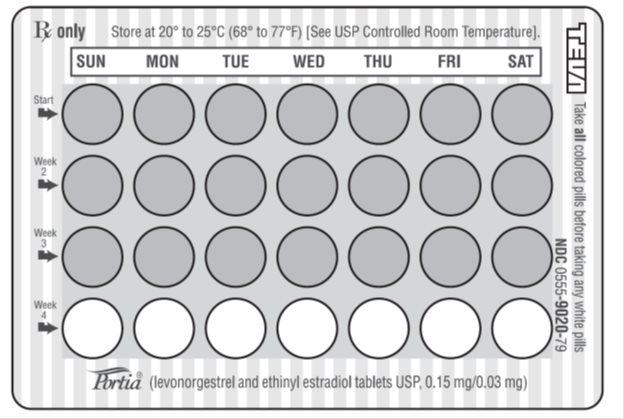
- Also find:
- Where on the card to start taking pills (upper left corner) and
- In what order to take the pills (follow the weeks)
- Be sure you have ready at all times another kind of birth control (such as condoms or spermicide), to use as a back-up in case you miss pills.
When should I start taking Portia?
If you start taking Portia and you have not used a hormonal birth control method before:
- There are 2 ways to start taking your birth control pills. You can either start on a Sunday (Sunday Start) or on the first day (Day 1) of your natural menstrual period (Day 1 Start). Your healthcare provider should tell you when to start taking your birth control pill.
- If you use the Sunday Start, use non-hormonal back-up contraception such as condoms or spermicide for the first 7 days that you take Portia. You do not need back-up contraception if you use the Day 1 Start.
If you start taking Portia and you are switching from another birth control pill:
- Start your new Portia pack on the same day that you would start the next pack of your previous birth control method.
- Do not continue taking the pills from your previous birth control pill pack.
If you start taking Portia and previously used a vaginal ring:
- Start using Portia on the day you would have started the next ring.Ā
If you start taking Portia and previously used a transdermal patch:
- Start using Portia on the day you would have started a new cycle (first patch application).
If you start taking Portia and you are switching from a progestin-only method such as an implant or injection:
- Start taking Portia on the day of removal of your implant, or on the day when you would have had your next injection.
If you start taking Portia and you are switching from an intrauterine device or system (IUD or IUS):
- Start taking Portia on the day of removal of your IUD or IUS.
- You do not need back-up contraception if your IUD or IUS is removed on the first day (Day 1) of your period. If your IUD or IUS is removed on any other day, use non-hormonal back-up contraception such as condoms or spermicide for the first 7 days that you take Portia.
Keep a calendar to track your period: If this is the first time you are taking birth control pills, read, āWhen should I start taking Portia?ā above. Follow these instructions for either a Sunday Start or a Day 1 Start.
Instructions for using your Portia Pill Dispenser:
Sunday Start:
You will use a Sunday Start if your healthcare provider told you to take your first pill on a Sunday.
- Take pill 1 on the Sunday after your period starts. To remove your pill from the dispenser, press the pill through the hole in the bottom of the dispenser.
- If your period starts on a Sunday, take pill "1" that day and refer to Day 1 Start instructions below.
- Take 1 pill every day in the order on the pill dispenser at the same time each day for 28 days.
- After taking the last pill on Day 28 from the pill dispenser, start taking the first pill from a new pack, on the same day of the week as the first pack (Sunday). Take the first pill in the new pack whether or not you are having your period.
- Use non-hormonal back-up contraception such as condoms or spermicide for the first 7 days of the first cycle that you take Portia.
Day 1 Start:
You will use a Day 1 Start if your doctor told you to take your first pill (Day 1) on the first day of your period.
- Take 1 pill every day in the order of the pill dispenser, at the same time each day, for 28 days. To remove your pill from the dispenser, press the pill through the hole in the bottom of the dispenser.
- After taking the last pill on Day 28 from the pill dispenser, start taking the first pill from a new pack, on the same day of the week as the first pack. Take the first pill in the new pack whether or not you are having your period.
What should I do if I miss any Portia pills?
If you miss 1 pill in Weeks 1, 2, or 3, follow these steps:
- Take it as soon as you remember. Take the next pill at your regular time. This means you may take 2 pills in 1 day.
- Then continue taking 1 pill every day until you finish the pack.
- You do not need to use a back-up birth control method if you have sex.
If you miss 2 pills in Week 1 or Week 2 of your pack, follow these steps:
- Take the 2 missed pills as soon as possible and the next 2 pills the next day.
- Then continue to take 1 pill every day until you finish the pack.
- Use a non-hormonal birth control method (such as a condom or spermicide) as a back-up if you have sex during the first 7 days after missing your pills.
If you miss 2 pills in a row in Week 3, or you miss 3 or more pills in a row during Weeks 1, 2, or 3 of the pack, follow these steps:
- If you are a Day 1 Starter:
- Throw out the rest of the pill pack and start a new pack that same day.
- You may not have your period this month, but this is expected. However, if you miss your period 2 months in a row, call your healthcare provider because you might be pregnant.
- You could become pregnant if you have sex during the first 7 days after you restart your pills. You MUST use a non-hormonal birth control method (such as a condom or spermicide) as a back-up if you have sex during the first 7 days after you restart your pills.
- If you are a Sunday Starter:
- Keep taking 1 pill every day until Sunday. On Sunday, throw out the rest of the pack and start a new pack of pills that same day.
- Use a non-hormonal birth control method (such as a condom or spermicide) as a back-up if you have sex during the first 7 days after you restart your pills.
If you have any questions or are unsure about the information in this leaflet, call your healthcare provider.
This Patient Information and Instructions for Use have been approved by the U.S. Food and Drug Administration.
Teva Pharmaceuticals USA, Inc. North Wales, PA 19454
Rev. A 11/2021Ā
Package/label Display Panel
NDC 0555-9020-58
6 Buler Cards, 28 Tablets Each
PortiaĀ®
(levonorgestrel and
ethinyl estradiol tablets USP)
0.15 mg/0.03 mg
Contains 6 buler cards, each containing 28 tablets. Twenty-one pink
tablets, each containing 0.15 mg levonorgestrel, USP with 0.03 mg
ethinyl estradiol, USP and seven white inert tablets.
Rx only
SHAPING
WOMENāS HEALTHĀ®
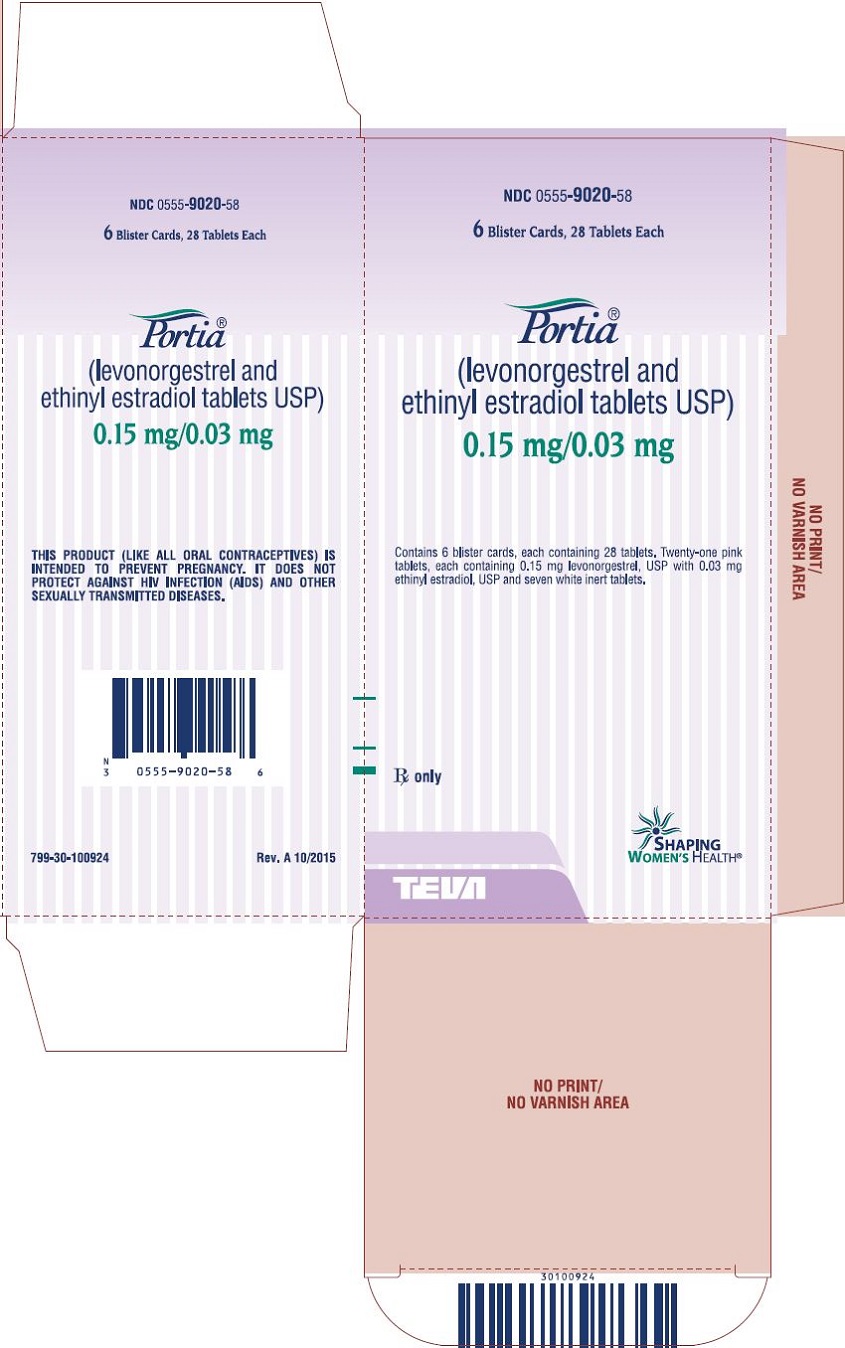
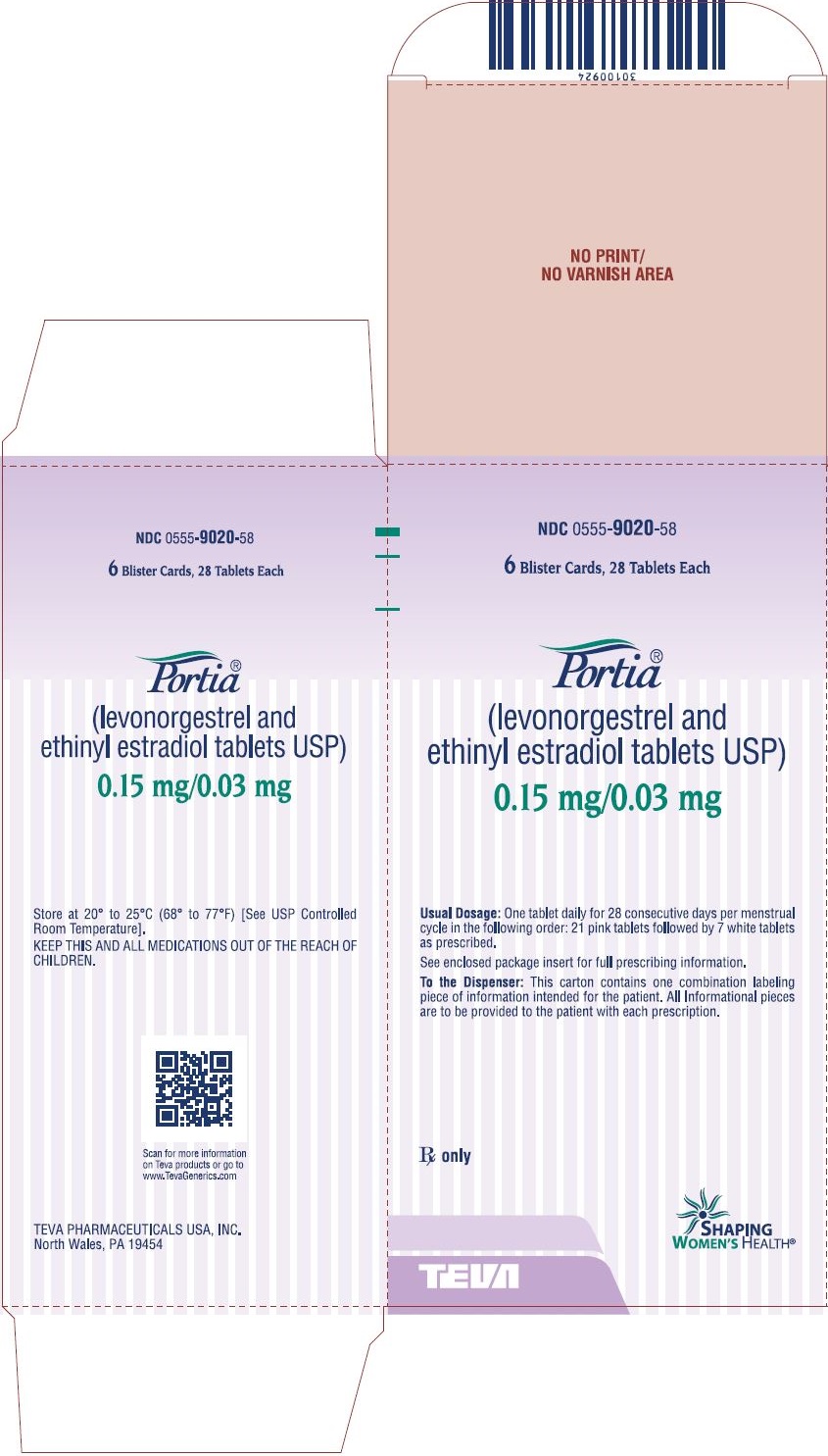
DISCLAIMER:
"This tool does not provide medical advice, and is for informational and educational purposes only, and is not a substitute for professional medical advice, treatment or diagnosis. Call your doctor to receive medical advice. If you think you may have a medical emergency, please dial 911."
"Do not rely on openFDA to make decisions regarding medical care. While we make every effort to ensure that data is accurate, you should assume all results are unvalidated. We may limit or otherwise restrict your access to the API in line with our Terms of Service."
"This product uses publicly available data from the U.S. National Library of Medicine (NLM), National Institutes of Health, Department of Health and Human Services; NLM is not responsible for the product and does not endorse or recommend this or any other product."
PillSync may earn a commission via links on our site


